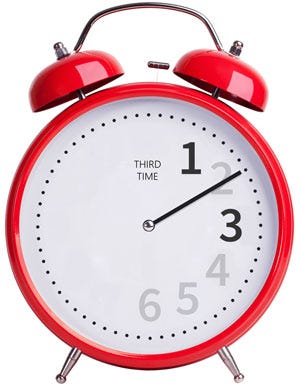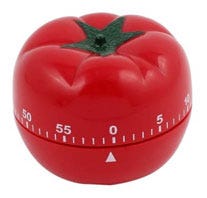HOW CAN you be more productive? Instead of half-working all day, it’s better to work in focused stints, with breaks in between to recover.
There are various ways to do this, but best of all might just be my new technique, called Third Time. The gist of it is:
- Work for as long or as short as you like, until you want or need to break; then
- Break for up to one-third of the time you’ve just worked.
So after 15 minutes of dealing with emails, you could stop for up to 5 minutes. After an hour-long meeting, you can take a good 20-minute break. And if a task bores you after 3 minutes, you can even break then — but only for 1 minute! Breaks reward you for working, but proper breaks have to be earned.

This kind of pattern is natural; research confirms that people tend to take longer breaks after working for longer. (One-third is just a recommendation; you can use other break fractions if you prefer.)
Third Time has many advantages over other techniques such as Pomodoro (which I’ll discuss later), but the key one is flexibility. It adapts to your attention span, energy, and schedule, as well as to other people and events. And Third Time isn’t just for your day-job — it suits anything that needs focus or effort, such as studying, practicing an instrument, personal admin, writing, or fitness training.
Using Third Time
Here’s an example of the basic procedure:
- Note the time, or start a stopwatch
- Work for as long or short as you like, until you want or need to break
- Suppose you worked for 45 minutes. This earns you 45 ÷ 3 = 15 minutes off; so set an alarm for 15 minutes
- Break until the alarm goes off
- Go back to step 1.
Breaks
You needn’t take the full break. Maybe you have a tight deadline, an important customer calls, you’re keen to resume work, or only have a short gap before a meeting. Whatever the reason, if you end a break (say) 5 minutes early, add 5 minutes to your next break. You don’t lose the remaining time, it’s just postponed:

You can shorten and postpone breaks like this, but don’t let them overrun. Break time must be earned by working; it’s like a debit card, not a credit card. So always set an alarm for the end of a break, and resume work as soon as it goes off (don’t snooze it!)
Take breaks whenever you like. Surprisingly, you’ll still end up doing the same amount of work! For example: instead of working for 45 minutes plus a 15-minute break, suppose you do just three minutes’ work plus a one-minute break, and repeat that over and over again. You’ll still be working three-quarters of the time; so in an hour, you’d still get 45 minutes’ work done.
That said, it’s annoying to end a break after just one minute, and keep switching back and forth. So even with tedious tasks, you’ll soon find yourself working longer — and perhaps even enjoying it — to earn a decent break.
While breaking too often is counterproductive, so is breaking too seldom, such as when immersed in an interesting project. Notice when you start to flag, and give yourself a break, to restore focus and avoid burnout.
Take proper breaks. Don’t think, talk or read about work. Instead, get up, walk around, drink water, go outside, chillax. (There’ll be more about how to work & break properly in Part 2 of this article.)
Though it’s best to choose when to work and break yourself, nothing changes if others are in charge. Suppose your boss fixes an hour-long meeting for you, then a five-minute gap, followed by a video call. The meeting earns you a 20-minute break; you can only take five minutes of it, but just add the remaining 15 minutes to your next break. (And if you really can’t take a full break then, carry the leftover time forward again, and so on.)
Interruptions
Similarly, nothing special happens if you get a work-related interruption, e.g. your boss calls you while you’re hard at it. The call is still work, so the clock keeps ticking. Either deal with the interruption, or postpone it (e.g. send to voicemail) and resume what you were doing.

Personal interruptions are different. Suppose you’re working from home, and the doorbell rings: this isn’t work, so a break starts then. Once the interruption is over, figure out when you stopped work, and hence when this break should end (by dividing by 3 as usual). Then either take the rest of the break, or resume work (saving the remaining break time for later). If you’ve already overrun the end of the break, start work immediately.
Meal breaks & big breaks
Most people stop work for lunch, some for dinner. With Third Time, you can divide the day into two or three separate sessions — morning, afternoon, maybe evening — to allow for proper meal breaks between.
If you only take a short time off for lunch, a normal break may suffice for it. For instance, an hour-long meeting just before lunch earns you a 20-minute break — enough to eat at your desk, anyway. Or you could save up more eating time by shortening earlier breaks. If you have lunch in a normal break like this, meals need no special treatment, and your whole workday is a single session.
But if a normal break won’t do, you can take a big break. This means a meal break that lasts as long as you like — longer than you’ve earned from previous work. The only constraint is that you must decide at the start of the break when to resume work, then set an alarm, and obey it as usual. This stops you getting lazy.
If you work into the evening, you can extend dinner in the same way: when a normal break isn’t long enough, you can take a big break, provided you set an alarm first. But only take big breaks for lunch and dinner.
Break minutes you’ve earned are used up by a big break, so you can’t carry them over to the afternoon/evening. Each session starts with a clean slate. (Hence you don’t need to time the work stint just before the meal.) Similarly, you can’t carry unused breaks over from one day to the next.
Sometimes you’ll have a personal task, e.g. going out to buy something, that’s too long to do in a normal break. If possible, do it in a big break, or before/after work. Try to avoid taking unofficial breaks for errands or anything else, lest you allow more and more exceptions to the system, and relapse into chaos.
Other fractions

What matters is not the absolute length of work and breaks, but their length relative to each other. Not enough breaks per hour worked, and you burn out; too many, and you don’t get enough things done.
Fitness training and other physical activities follow the same principle. For instance, with high-intensity interval training (HIIT) you might rest for half of the time you work: between 20-second sprints, you’d rest for 10 seconds; after a 2-minute dash, rest for 1 minute.
Third Time recommends breaking for one-third of your work time (a similar proportion to the Pomodoro and DeskTime techniques). If this sounds lax, a survey showed Britons spend less than half their time in the office actually working! So, with Third Time, you’ll accomplish much more than many people — particularly if you keep your work highly focussed, with no distractions.
But instead of one-third, you can use whatever fraction you like, such as:
- 1/2: 40 mins work + 20 mins breaks per hour. Working 2/3 of the time. Lazy
- 1/3: 45 mins work + 15 mins breaks per hour. Working 3/4 of the time. Standard
- 1/4: 48 mins work + 12 mins breaks per hour. Working 4/5 of the time. Industrious
- 1/5: 50 mins work + 10 mins breaks per hour. Working 5/6 of the time. Hard
- 1/6: 51½ mins work + 8½ mins breaks per hour. Working 6/7 of the time. Grinding
If you take a big break, you could shrink your other breaks by using a smaller fraction. For instance, neuroscientist Dr Daniel Levitin suggests working 90-minute stints with 15-minute breaks, plus a long lunch. A fraction of 15 ÷ 90 = 1/6 will achieve this.
Should a deadline or crisis strike, so you need to get a lot done fast, don’t abandon Third Time — just switch to a smaller fraction. Or save up breaks and use them later. Conversely, if you’re tired, or there’s not much to do, you could try a bigger fraction to get more breaks.
Different break fractions also suit different activities, from the gym to piano practice.
The other fractions, above right, let you calculate how much work you’ve done, or will do, without needing a timesheet or schedule. For example, Third Time’s default of 1/3 makes you work 3/4 of the time, so in an eight-hour day you’d complete six hours’ work — regardless of how your meetings, appointments, and interruptions pan out. (To calculate how long you worked if you took a big break, or didn’t use all your breaks, see footnote.*)
Advantages of Third Time

Various time management techniques involve working for fixed time periods. The most popular one, named Pomodoro after a tomato-shaped timer, alternates 25-minute work stints with 5-minute breaks (or occasionally longer).
While there are benefits to this kind of pattern, there are big problems too, which I discuss in another article. In a nutshell, fixed time periods are unnatural and mechanical; thoughtful, creative work doesn’t watch clocks. And it’s hard to work with other people this way, as their meetings, calls and interruptions won’t fit in with your timeslots. Nor will crises and deadlines. Basically, techniques like Pomodoro are too rigid.
This is because they insist on regulating your work. Third Time’s key insight is that this is unnecessary — you can guarantee how much work you’ll do, just by limiting breaks. This gives you complete freedom in how to divide up your day.

People work best with loose constraints, somewhere between total freedom and total restriction. Total freedom is anarchy — the life of the lazy, the workaholic, and the procrastinator. Total restriction is tyranny — ruled by a despotic tomato, and forced to work like a robot.
Third Time applies a light touch, keeping you in the happy, creative zone between these extremes. Its flexibility is its big advantage over other systems:
- Break whenever you want or need to, to suit your attention span, energy, schedule, and the task at hand
- You get the same amount of work done, however often you break!
- Third Time accommodates meetings, appointments, calls, interruptions, meals, and personal tasks
- Unlike Pomodoro, you’re not limited to working alone, and you can use it all day
- When on a roll, you don’t get interrupted by alarms for the end of fixed time stints
- Save up unused break time for later
- Choose a break fraction to suit you, or even vary it with the situation
- With tedious work, ploughing on rewards you with a longer break — an incentive to keep going
- With a deadline or crisis, you can take quick, occasional breaks, or none at all. Third Time automatically makes up the shortfall once the storm has passed.
If you like Pomodoro or other methods (e.g. the pressure of their short-term deadlines), you can still use them with Third Time to get the best of both worlds, as it doesn’t forbid fixed work stints. I’ll explain more in Part 2 of this article. In fact, Third Time is really a general form of time management technique that encompasses the others, and solves their flaws.
Other benefits of Third Time include:
- Encourages focussed work and proper breaks, rather than inefficient half-working (more in Part 2)
- Ensures you don’t underwork or overwork
- Easy to calculate how many hours’ work you’ve done or will do, without a timesheet or schedule
- You can even knock off work early every day (see Part 2)
- It’s not just for work — use Third Time for study, sport & fitness training, personal admin, hobbies, etc. — anything that needs prolonged focus or effort.
Summary
Lastly, here in one place are all the steps for using Third Time:
- Note the time, or start a stopwatch
- Work until you want or need to break
- Divide how long you’ve just worked by 3 (or use your chosen fraction), and add any minutes left over from previous breaks
- Set an alarm for that long
- Break until the alarm goes off, or you decide to resume work
- If you resume early, note how much time was left, to add to your next break
- Go back to step 1.
Additional rules:
- If you have to stop work for a non-work-related interruption, start a break immediately.
- You can (optionally) take a big break for lunch and/or dinner, lasting as long as you like. Set an alarm at the start for when you’ll resume work. A big break uses up any saved break minutes, so you can’t carry them over to the afternoon/evening.
- Avoid taking other unearned breaks if possible — so try to do personal tasks during normal or big breaks, or before/after your work day.
(Third Time would also work well in a smartphone/web app, or smart speaker skill. Anyone want to create one?)
________________________
If you found this article half-interesting, please scroll to the bottom to share or subscribe.
Part 2 (coming soon) will include tips on how to work and break properly, and using Third Time with other time management systems. Follow/subscribe to read it when it’s out.
Why not also try Hopscotch, my way of prioritizing what you work on?
________________________
*To the day length, add any break minutes left over at the end of the day (including any earned by your final work stint). If you took a big break, subtract its length, and add the break minutes you had earned or saved up just before the meal. Then multiply the total by 3/4 (for the default break fraction of 1/3); or for a break fraction of 1/n, multiply by n/(n + 1).
Thanks to Cat and Ari for many suggestions & comments
Photos: Shutterstock

I found the third time (rational breaks) focus protocol works extremely well for me, and surprisingly no one has made a good tool for it yet. So I decided to make a gamified version of this – it’s also has a lot of social co-working elements in it. The best thing is you get to collect Focumon! A tribute to the classical Pokemon games I loved as a kid. Check it out here and let me know what you think: https://www.focumon.com/about
Hi Ben,
Firstly, a thank you. Combining this with Hopscotch, I’ve seen huge improvements in productivity, focus, and happiness. Thank you for taking the time to develop them both and share them.
It’d be great to hear more of your thinking around this. When is the promised Part 2 on its way?